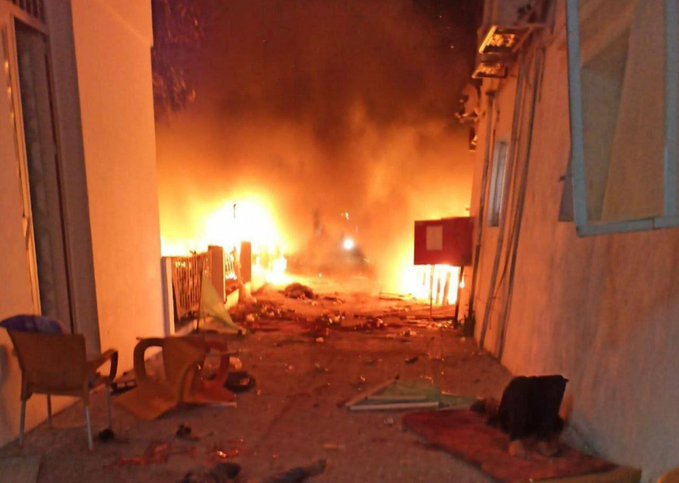A BLAME war has erupted between Hamas and Israel over a lethal explosion at a Gaza hospital.
Hamas terrorists accused Israeli warplanes of deliberately bombing the Al-Ahli al-Arabi hospital and sparking a fireball they claimed killed 500 late on Tuesday.
Photos from inside the hospital amid the fireball explosion
IDF data claims the deadly rocket was launched from Gaza before it failed close to the Al-Ahli Hospital
But Israel has hit back with a furious denial as question marks hang over the cause of the tragedy.
Israeli military chiefs insist the devastation was triggered by a rocket misfired by Hamas allies Palestinian Islamic Jihad.
They claim their terrorist enemies also falsely inflated the casualty figure as tensions boil over in the Middle East region.
Joe Biden last night backed Israel’s denial of responsibility – and five key pieces of evidence appear to suggest the strike indeed came from Gaza.
Intercepted audio
Twitter @yzarkaAlleged Hamas terrorists discussed who launched the device in intercepted audio[/caption]
The IDF released a recording of what it claimed to be an intercepted phone call between two Hamas terrorists.
They can allegedly be heard confirming the rocket was fired from a cemetery close to the hospital by Palestinian Islamic Jihad.
The potentially damning audio was intercepted moments after the blast.
One says: “They are saying (the rocket) belongs to Palestinian Islamic Jihad.”
“It’s from us?” another asks. “It looks like it,” the first voice responds.
“They are saying the shrapnel that fell from the missile is local shrapnel and not like Israeli shrapnel. It misfired and fell on them.”
Sound of blast
TwitterThe hospital blast was caused by the Islamic Jihad rocket, according to Israel[/caption]
Experts believe the sound of the projectile made as it fell and hit the ground suggests the blast was not caused by an Israeli missile.
Leading airpower pro at the Rusi think tank Justin Bronk said the weapon sounded under-powered in footage shared online.
He tweeted: “For what it’s worth, this doesn’t look or sound quite like an air strike using the typical IAF 1000lb or 2000lb JDAM/Mk80 series to me.
“Incoming projectile sounds like it’s under power and the explosion frames visible look like largely propellant fire rather than HE detonation.”
Hamas militants are known to build rockets from improvised materials as an Israeli blockade stops military shipments entering Gaza.
Video evidence
Twitter @IDFVideo footage shows an object appearing to fall toward the al-Ahli hospital, causing an explosion upon impact[/caption]
Another key clue is livestream footage from Al Jazeera with a timestamp of 18:59 — matching the timing of the explosion.
The clip shows what appears to be a failed projectile exploding mid-air, prompting an object to fall on the hospital site.
This is consistent with Israeli claims the blast was caused by propellant from a misfired Islamic Jihad rocket igniting, rather than an Israeli warhead blast.
A video clip aired on Israeli Channel 12 News also appeared to show a salvo of rockets being launched from within Gaza before the explosions rocked the hospital.
Intercept evidence — point 3 — also points to the Israeli account being correct.
Blast pattern and damage
Photos of the aftermath suggest it was not an airstrike as there is just a small craterGetty
The trajectory of the blast and its damage are also vital evidence.
Footage shows rockets fired east from Gaza towards Israel shows one appearing to burst into flames mid-flight.
This could have showered shrapnel on the ground.
The hospital is located between where the alleged misfired rocket was launched and the Israeli border.
Pictures also reveal minimal damage to the hospital itself – despite Hamas’ claims.
Only a small crater is visible on pictures taken at the scene.
Instead of being destroyed, cars are pictured showing only fire damage. The walls of the hospital remain intact.
Buildings close to the hospital do not appear to show significant damage either.
Israeli aerial attacks are usually so powerful as to collapse nearby buildings.
Nathan Ruser, an analyst with the Australian Strategic Policy Institute, said photos of blast damage were “not consistent with an airstrike”.
He added: “They are not consistent with claims that 500-plus people were killed.
“The fact there’s only a very small crater is very inconsistent with an air strike, as is the amount of kinetic damage to the cars that were almost directly hit.
“It looked that most of the damage was done through fire, which is consistent with a rocket that had a lot of fuel in it and, when it failed, was able to spread a fire across a relatively large area.”
Satellite data
An Israeli map pinpoints the ‘Gaza launch site’Twitter @IsraelMFA
Satellite images show the relatively small area of the blastReuters
Satellite data is also compelling in Israel’s denial.
Paul Beaver, a British defence analyst, told The Times extensive satellite and mobile phone images showed the rocket responsible for the explosion was ground-launched, not air-launched.
He added: “You can tell from the plume of smoke that it has come from a ground-launched rocket.
“The Israeli air force has been using precision-guided bombs, not dumb (unguided) bombs on Gaza and these weapons don’t generate a plume.
“Anyway, the rocket was going the wrong way. The laws of physics are on the Israelis’ side.”

